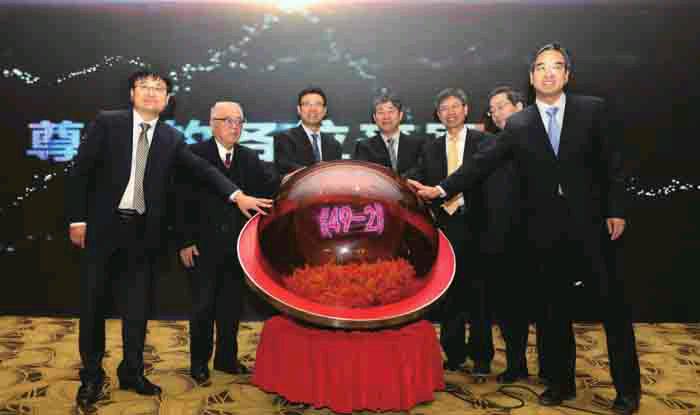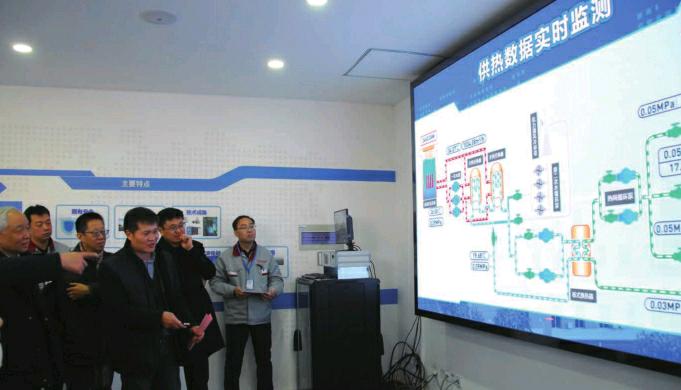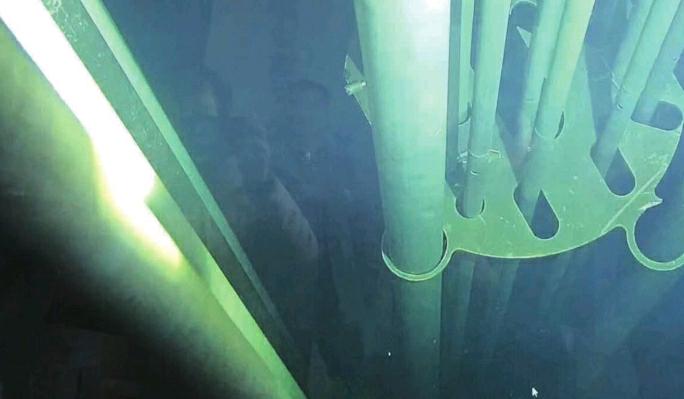Clean Heating
2018-01-09ByLiNan
By+Li+Nan
It was not until the winter of 2017 that Dong Jianli felt the heat produced by a nuclear reactor up close, even though she had worked at the China Institute of Atomic Energy (CIAE) for more than a decade. From November 20 to 28, 2017, the heat emanating from the radiators in her offi ce was being generated by a nuclear reactor, a fi rst in the 67-year history of CIAE, Chinas fi rst nuclear research arm.
In November 2017, CIAE began to heat three of its buildings using one of its longestserving reactors, the 49-2 Swimming-Pool Reactor (49-2 SPR). The reactor worked perfectly for 168 consecutive hours, keeping the indoor temperature steady at 23 degrees Celsius.
“They were hotter than other gas-fired radiators. I didnt feel cold in the offi ce even when only wearing a thin T-shirt,” Dong, a seasoned administrator with Beijing-based CIAE, told Beijing Review. During that week, she couldnt help touching the hot radiators every morning, a ritual borne of curiosity for the power and potential of this technology.
After a safe, week-long trial operation, China National Nuclear Corp. (CNNC), parent company of CIAE, launched its nuclear heating system Yanlong in Beijing on November 28, 2017, a green heating solution which harnesses the heat generated by a small nuclear reactor.
Yanlong is a pool type low-temperature heating reactor. A 400-megawatt Yanlong, also known as DHR-400, is expected to be used as a source of indoor heating for a maximum area of 20 million square meters, roughly equivalent to 200,000 threebedroom apartments. According to these calculations, a single DHR-400 can supply heating for nearly 500,000 citizens, roughly the average population of a Chinese county.
The launch of Yanlong is the first step of CNNCs ambitious plan to boost nuclear heating in north China in the coming years. The organization expects to build pilot nuclear-fi red boilers by 2018 before putting them into commercial operation after 2020.
“49-2 SPRs safe 168-hour heat supply is significant for promoting green heating and curbing smog in northern China. Its a milestone in Chinas history of household heating, nuclear power and energy development,” said Liu Baohua, deputy chief of the National Energy Administration (NEA), at the launch ceremony of Yanlong in Beijing on November 28, 2017.
Advantages
“Yanlong is a safe, energy effi cient and environmentally friendly heating system. Its easy to install and to integrate within existing city heating systems,” Ke Guotu, chief designer of the reactor, told Beijing Review.endprint
Saving more energy and emitting little waste, Yanlong is a new and green substitute for fossil fuel-fi red boilers. According to Ke, a 400-megawatt nuclear heating reactor can generate as much heat per year as the burning of 320,000 tons of coal or 160 million cubic meters of natural gas, and Yanlong releases no carbon dioxide or dust into the air. Yanlong, if used as an alternative to coalfi red or gas-fi red boilers of the same supply capacity, will reduce emissions of carbon dioxide by 640,000 tons or 204,600 tons per year.
Coal-fired boilers have long been one of the primary causes of north Chinas frequent haze, especially in the Beijing-TianjinHebei region. “More than 20 percent of the end-use energy consumption in China was generated by coal, 10 percentage points higher than the global average,” reads the 13th Five-Year Plan for Energy Development released by the NEA in December 2016.
“If nuclear power can be used for residential heating, the PM2.5 generated by boilers now will be completely eradicated. That is signifi cant for curbing smog in China,”Wang Yuanfeng, a civil engineering professor with Beijing Jiaotong University (BJTU) told Beijing Review.
In addition, China has vowed to increase the share of non-fossil fuels in its primary energy consumption to 20 percent by 2030, while ensuring that carbon emissions peak around the same time. Curbing coal consumption and increasing the usage of non-fossil sources of energy are seen as two critical measures necessary for China to build a clean and low-carbon energy system in the coming years.
Latest NEA figures show that China slashed its coal consumption by 4.7 percent year on year, and increased its non-fossil energy consumption to 13.3 percent in 2016, but “there is a long way to go before China begins realizing the goal for 2030,” reads the 13th Five Year Plan for Energy Development.
“Yanlong offers a new heating option for north China, and since nuclear power is a key part of the energy system, it is expected to help China deliver on its promises regarding climate change to some extent,” Wan Gang, head of CIAE, told Beijing Review.
“Yanlong is the outcome of a mature technology. Its safe,” said Ke. The reactor is submerged in a well-sealed underground pool surrounded by more than 1,800 tons of water. This abundant water supply ensures the core cannot be exposed.
The system through which heat generated by the reactor is exchanged to household heating radiators relies on three isolated pipe circuits. This means that water from the reactor pool will not fl ow into the city heating system and neither will any radioactive substance.endprint
Statistics from CIAE show that the radiation levels in the nuclear-heated buildings remained at 0.12μSv per hour during the trial, a reading indistinguishable from those taken when they were heated by natural gas, and equivalent to the natural background radiation dose, which is considered safe for humans.
In the case of severe accidents, such as earthquakes, the reactor, triggered by a negative reactivity feedback, will shut down automatically averting the possibility of a meltdown. “The technology of a pool type, low-temperature heating reactor is proven to be reliable. Disasters like those that occurred in Chernobyl and Fukushima cannot happen here,” said Ke.
The idea of designing a low-temperature heating reactor was first raised in China in 1981, and after decades of study, Chinese scientists have now built more than 10 pool type reactors for research purposes, maintaining a record of safe operation for over 300 reactor years. Yanlong is the fruit borne of these scientifi c endeavors.
Low costs are another of Yanlongs selling points. To produce a gigajoule of heat with a DHR-400 costs just 30-40 yuan($4.58-6.1), on par with traditional coal-fi red boilers, and around 40 percent of the cost to produce the same amount using a gas-fi red boiler. “I think Yanlong, as cheap as coal and cleaner than gas, will be popular in the future residential heating market,” He Bingqing, Deputy Director of the Consultation and Research Center of the Ministry of Land and Resources (MLR), told Beijing Review.
As of December 2016, the Beijing-TianjinHebei region had launched a clean heating campaign to introduce gas-fi red boilers and electric heaters, ditching the old, polluting systems that relied on coal. However, the campaign was thwarted in parts of Hebei Province as 2017 witnessed a natural gas shortage which drove up gas prices, making both gas and electricity expensive heating options for the residents.
Yanlong makes it possible to turn coalfired boilers into clean energy-fired ones at an affordable price, said He.
According to CIAEs Ke, building a pool type low-temperature heating reactor will cost 1.5 billion yuan ($228.8 million), two to three times more than the construction costs for a coal-fi red boiler of the same heating capacity. Given that a reactor can serve for 60 years, two to four times the length of a coal-fi red equivalent, the overall operation cost of Yanlong is ultimately lower than that of coal-fi red heating mechanisms. “If a reactor with an investment of 1.5 billion yuan can serve 500,000 people for 60 years, then to me it seems that its long-term benefi t is impressive and its cost is inexpensive,” said He of the MLR.endprint
“Using nuclear power to supply heating is expected to optimize Chinas energy system, and ease its growing energy crisis. It also offers an effective way to reduce emissions and to drive away the lingering haze veiling the north of the country. It is a necessary step toward protecting Chinas environment and safeguarding peoples health,” Liu Hua, Vice Minister of Environmental Protection, said at the launch ceremony.
Resistance ahead
Yet despite the economic and environmental benefits, Yanlongs journey toward widespread marketability does not look set for plain sailing. “Acceptance of nuclear power is the biggest hurdle for Yanlong to be commercialized,” said Ke. Most Chinese feel apprehensive about the use of nuclear energy, especially after the Fukushima nuclear disaster in 2011. This public unease extends to all matters nuclear, as seen in August 2016 when the site selection for a planned Sino-French nuclear fuel reprocessing project was halted following protests in Lianyungang, east Chinas Jiangsu Province.
The management of nuclear waste poses another challenge. Reprocessing and recycling uranium and plutonium is a renewable way to deal with used fuels, wrote Wang Yongzhong and Wan Jun, scholars with the Institute of World Economy and Politics of the Chinese Academy of Social Sciences in a recent article published by the Peoples Daily.
Lu Fengding, former Chinese Ambassador to Sweden, believes that a multi-pronged promotional campaign is necessary to help the public know more about nuclear power. The media, including social networks, should communicate more objective information about nuclear energy, and education pertaining to nuclear power should be strengthened on campuses. “Of course, more scientifi c breakthroughs in this regard are expected. After all, the facts speak for themselves,” Lu told Beijing Review.
Another challenge facing Yanlongs advocates is how to attract private investors to engage in the operation of a pool type lowtemperature heating reactor, along with the costs necessary to guard its safety at the same time. “Different from ordinary boilers, every nuclear reactor has to be guarded by an armed police force. If such reactors are widely used for Chinas residential heating, ensuring the safety of sites scattered throughout many cities and towns could be a problem,” said BJTUs Wang. The Chinese Government has to implement a reliable mechanism before commercializing nuclear power heating, Wang added.endprint
